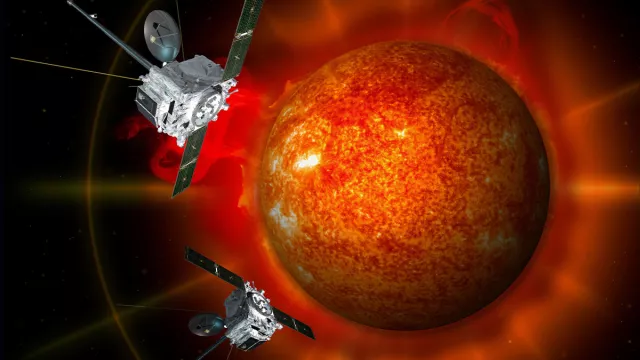STEREO is a U.S. mission to observe the Sun with twin satellites launched in 2006. With support from CNES, several French laboratories helped to build STEREO’s instruments, which are still operating.
Key information
Key figures
- 2 twin satellites
- 620 kg: mass of each satellite
- 4 instruments and instrument suites on the 2 satellites
- 3 contributing French laboratories
Key milestones
- 17 October 2018: End of mission for STEREO-B, STEREO-A still operational
- 23 September 2016: NASA loses contact with STEREO-B
- 2015: The two satellites are above the same longitude of the Sun
- 6 February 2011: The two satellites are phased 180° apart, on directly opposite sides of the Sun
- April 2009: The two satellites arrive at the L4 and L5 Earth Lagrange points
- 24 January 2009: The two satellites attain 90° separation with respect to the Sun
- 25 October 2006: STEREO-A and STEREO-B launched by Delta II 7925-10L
Project in brief
The STEREO mission (Solar TErrestrial RElations Observatory) comprises twin satellites orbiting the Sun, one ahead of the Earth (STEREO-A) and the other trailing behind it (STEREO-B), thus offering the ability to view from two different vantage points in space. STEREO has acquired the first 3D images of coronal mass ejections (CMEs) and how they interact with the interplanetary medium.
The twin satellites are carrying the same four instruments and were launched on 25 October 2006 on the same Delta II vehicle from Cape Canaveral, Florida. After launch, they gradually moved out of Earth orbit until in 2011 they were 180° apart, making it possible to view both sides of the Sun simultaneously for the first time. In 2015, they were observing the side of the Sun not visible from Earth. A CNES antenna near Toulouse has been receiving data continuously from the two satellites since 2006.
STEREO is the third mission of the international Solar Terrestrial Probes programme (STP). STEREO-A and its instruments are functioning nominally, whereas STEREO-B is no longer in contact with Earth since 2014. STEREO serves as an in-situ measurement point on its orbit (with WIND) to enable correlations with measurements from Parker Solar Probe and Solar Orbiter.
CNES’s role
French research laboratories worked on some of STEREO-A and STEREO-B’s instruments with support from CNES. The LESIA space and astrophysics instrumentation research laboratory was the Principal Investigator for SWAVES, while the IAS space astrophysics institute and the Institut d’Optique Graduate School (IOGS) contributed to SECCHI. The IRAP astrophysics and planetology research institute developed the detectors for the IMPACT instrument. IAS is also involved in analysing data from the mission.
Contacts
Sun, Heliosphere & Magnetospheres subject matter expert
Kader Amsif
E-mail: kader.amsif at cnes.fr


